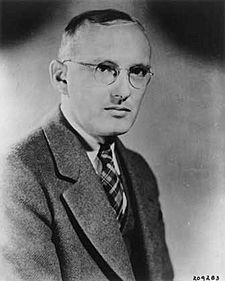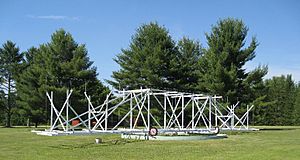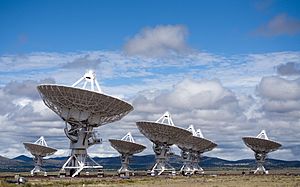Karl Guthe Jansky facts for kids
Quick facts for kids
Karl Guthe Jansky
|
|
|---|---|
 |
|
| Born | October 22, 1905 |
| Died | February 14, 1950 (aged 44) Red Bank, New Jersey, U.S.
|
| Nationality | American |
| Known for | Radio astronomy |
| Scientific career | |
| Fields | Physics Radio astronomy |
Karl Guthe Jansky (born October 22, 1905 – died February 14, 1950) was an American physicist and radio engineer. In April 1933, he made an amazing discovery. He found radio waves coming from space, specifically from the Milky Way galaxy in the direction of the Sagittarius constellation. Because of this, he is known as one of the main people who started the field of radio astronomy.
Contents
Early Life and Education
Karl Guthe Jansky was born in 1905 in what was then the Oklahoma Territory. His father, Cyril M. Jansky, was a professor and the head of the College of Engineering at the University of Oklahoma. Cyril M. Jansky was an engineer who loved physics, and he passed this interest on to his sons. Karl Jansky was named after Dr. Karl Eugen Guthe, a physics professor who was an important teacher and guide for his father.
Karl's mother was Nellie Moreau. His older brother, Cyril Jansky Jr., helped build some of the first radio transmitters in the United States.
Karl Jansky went to college at the University of Wisconsin. He earned his bachelor's degree in physics in 1927. In 1928, when he was 22, he started working at Bell Telephone Laboratories. Because of a kidney problem, he was sent to a healthier area in Holmdel, New Jersey.
Bell Labs wanted to study how radio waves traveled through the Earth's atmosphere. They were especially interested in "short waves" (radio waves about 10–20 meters long). This research was important for improving phone calls across the Atlantic Ocean. Jansky's job was to find out what caused "static" (noise) that could mess up these radio calls.
Discovering Radio Waves from Space
At Bell Labs, Jansky built a special directional antenna. This antenna was designed to pick up radio waves at a frequency of 20.5 MHz (which is about 14.6 meters in wavelength). The antenna was about 100 feet (30 meters) across and 20 feet (6 meters) tall. It was placed on a spinning platform, like a giant merry-go-round, which allowed it to turn and listen in different directions. People called it "Jansky's merry-go-round."
Jansky used this antenna to record radio signals from all directions for several months. He noticed three types of static:
- Static from nearby thunderstorms.
- Static from distant thunderstorms.
- A faint, steady static, like a "hiss," that he couldn't explain.
He spent more than a year trying to find out where this third type of static came from. He noticed that the strongest signal of this hiss appeared once a day. At first, he thought it might be coming from the Sun.
However, after a few months, the strongest signal moved away from the Sun's position. Jansky also found that the signal repeated every 23 hours and 56 minutes. He talked about this mystery with his friend, astrophysicist Albert Melvin Skellett. Skellett explained that 23 hours and 56 minutes is the exact length of a sidereal day. This is the time it takes for the Earth to rotate once, so that a distant star appears in the same spot in the sky.
By comparing his observations with star maps, Jansky realized the radio waves were coming from the Milky Way galaxy. The signal was strongest in the direction of the center of our galaxy, which is in the constellation of Sagittarius. This happened at 7:10 p.m. on September 16, 1932.
Jansky shared his discovery at a meeting in Washington D.C. in April 1933. Not many people at the meeting understood how important his findings were. However, his discovery was widely reported, including in New York Times on May 5, 1933. He was even interviewed on a special NBC radio show about "Radio sounds from among the stars." In October 1933, he published his findings in a science paper called "Electrical disturbances apparently of extraterrestrial origin."
Jansky wondered if the Sun also produced radio noise, but he found it did not. This was because the Sun was in a quiet phase of its sunspot cycle at that time. In 1935, Jansky suggested that these strange radio signals might be caused by hot, charged particles in the gas between stars. He made these important discoveries when he was still in his twenties, with only a bachelor's degree in physics.
Jansky wanted to study these Milky Way radio waves more after 1935. He even called the radiation "Star Noise" in his master's degree paper in 1936. But he didn't get much support. Astronomers weren't familiar with this new type of study. Bell Labs also didn't want to spend money on research that didn't directly help their phone systems, especially during the Great Depression.
What Happened Next
Several scientists were interested in Jansky's discovery. However, the field of radio astronomy didn't grow much for several years. This was partly because Jansky wasn't a trained astronomer. Also, his discovery happened during the Great Depression, so observatories were careful about starting new and possibly risky projects.
Two people who learned about Jansky's discovery in 1933 greatly helped the new field of radio astronomy:
- Grote Reber: He was a radio engineer who built a radio telescope in his own backyard in Illinois in 1937. He then made the first detailed maps of radio waves from space.
- John D. Kraus: After World War II, he started a radio observatory at Ohio State University. He also wrote a textbook on radio astronomy that became a standard for many years.
Legacy and Honors

Karl Jansky lived in Little Silver, New Jersey. He passed away at age 44 in a hospital in Red Bank, New Jersey, due to a heart problem.
To honor Jansky, a special unit of measurement used by radio astronomers is named the jansky (Jy). It measures the strength of radio sources in space. The Jansky crater on the Moon is also named after him.
The National Radio Astronomy Observatory (NRAO) has a special program for young scientists called the Karl Jansky postdoctoral fellowship. The NRAO also gives out the Jansky Prize every year to honor his work. On January 10, 2012, the NRAO announced that the Very Large Array (VLA), a famous radio telescope in New Mexico, would be renamed the Karl G. Jansky Very Large Array. This was to recognize Karl Jansky's important contribution to radio astronomy.
A full-size copy of Jansky's original rotating telescope is located at the Green Bank Observatory in Green Bank, West Virginia. This is near a rebuilt version of Grote Reber's radio dish.
The exact spot where Jansky's antenna stood is now at the Bell Labs Holmdel Complex in Holmdel Township, New Jersey. In 1998, scientists Tony Tyson and Robert Wilson found the original location. A monument and a plaque were placed there to honor his achievement. The monument is a sculpture that looks like the antenna. It is pointed in the same direction Jansky's antenna was at 7:10 p.m. on September 16, 1932. This was the moment when the signal was strongest, as it lined up with the center of our galaxy in the constellation Sagittarius.
The term Jansky noise is also named after him. It refers to static disturbances of cosmic origin, meaning they come from space.
Asteroid 1932 Jansky is named after him, as is the lunar crater Jansky.
Selected Writings
- Jansky, Karl Guthe (December 1932). "Directional studies of atmospherics at high frequencies". Proc. IRE 20 (12): 1920. doi:10.1109/JRPROC.1932.227477.
- Jansky, Karl Guthe (8 July 1933). "Radio waves from outside the solar system". Nature 132 (3323): 66. doi:10.1038/132066a0.
- Jansky, Karl Guthe (October 1933). "Electrical disturbances apparently of extraterrestrial origin". Proc. IRE 21 (10): 1387. doi:10.1109/JRPROC.1933.227458. Reprinted 65 years later as Jansky, Karl Guthe (July 1998). "Electrical disturbances apparently of extraterrestrial origin". Proc. IEEE 86 (7): 1510–1515. doi:10.1109/JPROC.1998.681378. along with an explanatory preface by W.A. Imbriale, Introduction To "Electrical Disturbances Apparently Of Extraterrestrial Origin" .
- Jansky, Karl Guthe (December 1933). "Electrical phenomena that apparently are of interstellar origin". Popular Astronomy 41: 548.
- Jansky, Karl Guthe (October 1935). "A note on the source of interstellar interference". Proc. IRE 23 (10): 1158. doi:10.1109/JRPROC.1935.227275.
- Jansky, Karl Guthe (December 1937). "Minimum noise levels obtained on short-wave radio receiving systems". Proc. IRE 25 (12): 1517. doi:10.1109/JRPROC.1937.228780.
See also
 In Spanish: Karl Guthe Jansky para niños
In Spanish: Karl Guthe Jansky para niños
- Reber Radio Telescope
- Astronomical radio source
- History of Radio Astronomy




